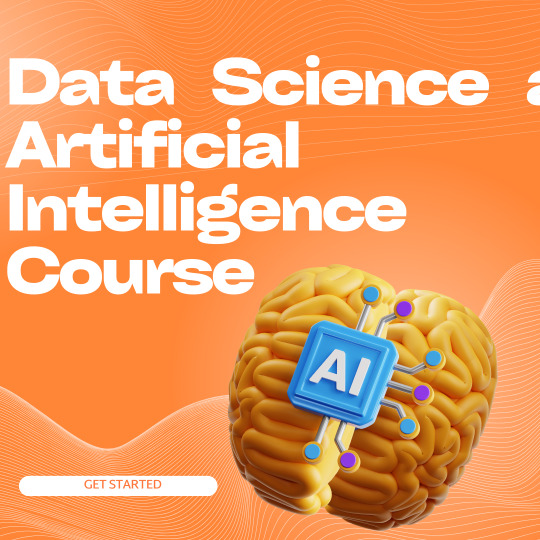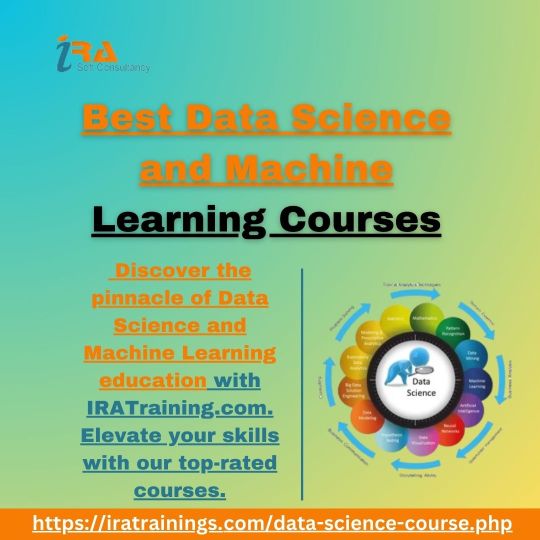#Online Data Science Course
Explore tagged Tumblr posts
Text

🎓 Advanced Data Science Course Online
🔍 What You Will Learn
💻 Top Tools & Technologies
📚 Course Features
👨💼 Ideal For
💼 Job Roles After Complete Course
🏫 Top Platforms Offering the data science course
0 notes
Text
Mastering NumPy Broadcasting for Efficient Computation

If you're working with Python for data science, you've probably come across NumPy, a powerful library for handling numerical data. One of NumPy’s standout features is broadcasting, which simplifies operations on arrays of different shapes without requiring manual adjustments. This not only enhances computational efficiency but also improves memory management, making it a must-know technique for data scientists and machine learning professionals.
In this guide, we’ll break down NumPy broadcasting, explaining how it works and why it’s a game-changer for high-performance computing. We’ll also explore real-world applications and discuss how you can master these skills through the Online Data Science Course UAE.
Why Does NumPy Broadcasting Matter?
When working with large datasets, efficiency is crucial. Traditional element-wise operations require arrays to have the same dimensions, which can lead to increased memory usage and slower execution times. Broadcasting eliminates this limitation by allowing NumPy to automatically adjust smaller arrays, ensuring they align with larger ones without duplicating data.
Key Advantages of Broadcasting:
Faster computations: Eliminates the need for explicit looping.
Optimized memory usage: Avoids unnecessary copies of data.
Simplifies code: Enhances readability by removing manual reshaping.
Understanding How NumPy Broadcasting Works
To apply broadcasting, NumPy follows a set of rules when performing operations on arrays of different shapes:
If the arrays have different dimensions, NumPy expands the smaller array by adding singleton dimensions (size 1) from the left until both arrays have the same number of dimensions.
If dimensions differ, those with size 1 are stretched to match the corresponding dimension of the larger array.
If the arrays are still incompatible, a ValueError is raised.
Example 1: Adding a Scalar to an Array
import numpy as np matrix = np.array([[1, 2, 3], [4, 5, 6]]) # Shape (2,3) scalar = 10 # Shape () result = matrix + scalar print(result)
Output: [[11 12 13] [14 15 16]]
Here, the scalar is automatically expanded to match the shape of the array, enabling efficient element-wise addition.
Example 2: Broadcasting a 1D Array to a 2D Array
matrix_2d = np.array([[1, 2, 3], [4, 5, 6]]) # Shape (2,3) vector = np.array([10, 20, 30]) # Shape (3,) result = matrix_2d + vector print(result)
Output: [[11 22 33] [14 25 36]]
NumPy expands the 1D array across rows to match the (2,3) shape, allowing seamless element-wise operations.
Example 3: Multi-Dimensional Broadcasting
array_3d = np.array([[[1], [2], [3]]]) # Shape (1,3,1) array_2d = np.array([[10, 20, 30]]) # Shape (1,3) result = array_3d + array_2d print(result)
Output: [[[11 21 31] [12 22 32] [13 23 33]]]
NumPy stretches the shapes to align properly and executes the addition efficiently.
Real-World Applications of NumPy Broadcasting
1. Speeding Up Machine Learning Workflows
Broadcasting is heavily used in data normalization for training machine learning models. Instead of manually reshaping arrays, NumPy allows quick transformations:
data = np.array([[50, 60, 70], [80, 90, 100]]) mean = np.mean(data, axis=0) norm_data = (data - mean) / np.std(data, axis=0)
This efficiently normalizes the dataset without unnecessary loops.
2. Image Processing
Broadcasting is widely applied in image manipulation, such as adjusting brightness levels across RGB channels:
image = np.random.rand(256, 256, 3) # A 256x256 RGB image brightness = np.array([1.2, 1.1, 0.9]) adjusted_image = image * brightness
Each colour channel is scaled independently, improving computational efficiency.
3. Financial & Statistical Analysis
In financial modeling, broadcasting simplifies calculations like percentage change computations:
prices = np.array([100, 102, 105, 110]) returns = (prices[1:] - prices[:-1]) / prices[:-1] * 100
This eliminates manual looping, making stock price analysis faster and more efficient.
Master Data Science with Boston Institute of Analytics (BIA) in UAE
If you're looking to enhance your expertise in data science, AI, and machine learning, mastering NumPy broadcasting is a crucial step. The Boston Institute of Analytics (BIA) offers a comprehensive Online Data Science Course UAE, covering:
Python Programming & NumPy Fundamentals
Advanced Machine Learning & AI Techniques
Data Visualization & Statistical Analysis
Big Data & Cloud Computing
Why Choose BIA?
Learn from Industry Experts: Gain insights from experienced data scientists.
Hands-On Projects: Work on real-world datasets for practical learning.
Globally Recognized Certification: Earn a professional credential to boost your career.
Flexible Online Format: Learn at your own pace, from anywhere in the UAE.
By enrolling in BIA’s Online Data Science Course, you’ll build a strong foundation in Python, NumPy, and advanced analytics techniques, preparing yourself for high-paying roles in data science.
Final Thoughts
NumPy broadcasting is a game-changer for anyone dealing with numerical computations. Whether you're working on machine learning models, image processing tasks, or financial data analysis, understanding broadcasting will help you write more efficient and scalable code.
Ready to take your data science journey to the next level? Join the Data Science Course today and gain industry-relevant skills that will set you apart in the competitive job market!
#data science course#data science training#online data science course#data science program#best data science programs#AI Training Program#Online Data Science Course UAE#Best Data Science Institute#Best Online Data Science Programs
0 notes
Text
https://iratrainings.com/data-science-course.php

Beginner to Pro: The Best Data Science Online Classes for Every Level
In today's digital world, mastering data science is a game-changer. Whether you are a complete novice or an experienced professional, data science online classes provide an excellent opportunity to enhance your skills from the comfort of your home. This guide explores the best data science online classes for beginners, intermediate learners, and advanced professionals, helping you choose the right path toward becoming a data science expert.
#data science online classes#data science course#online data science course#data science certification course#python data science course
0 notes
Text

Professional Certification in Data Science
MITSDE provides India's top online data science course, teaching essentials like data handling, visualization, predictive analytics, classification, and deep learning.
0 notes
Text
online data science course
https://iimskills.com/data-science-course/
A Data Science course equips students with essential skills to work with large datasets and uncover insights. It covers key areas like data collection, cleaning, and preprocessing, along with tools for data analysis and visualization. Students learn programming languages such as Python or R, and work with libraries like Pandas, NumPy, and Matplotlib.
0 notes
Text

Join Our Comprehensive Online Data Science Course | NIIT Digital
Learn data analysis, machine learning, and more with our online data science course. Gain practical skills and start your data science career today!
0 notes
Text
In conclusion, the answer to “Can BBA students become data scientists?” is a resounding yes. Embracing data science for BBA graduates opens doors to diverse and rewarding career opportunities across various industries. By acquiring data science skills, BBA students can leverage their business acumen to drive data-driven decision-making and unlock unprecedented growth and success.
Feel free to visit https://analyticsquare.co.in/ to know what all topics are covered in Data Science.
0 notes
Text
youtube
Think you know the Fibonacci sequence? Let’s make it interesting! In this unique Python tutorial, we’ll show you how to solve the Fibonacci problem using a twist — by incorporating the min() and max() functions. This is a creative approach to reinforce your understanding of loops, sequence logic, and Python's built-in functions in a fresh, engaging way!
0 notes
Text
Understanding Logical Operators in Python: AND, OR, NOT Explained

Logical operators are a fundamental aspect of Python programming, helping developers build effective decision-making structures and control flow in their applications. These operators—AND, OR, and NOT—allow programmers to implement complex conditions, making them essential for automation, data analysis, and artificial intelligence projects.
In this guide, we'll break down how these logical operators function, provide practical examples, and explore their real-world applications. Additionally, if you're eager to enhance your Python skills for AI and data science, consider enrolling in the Online Data Science Course US, where you’ll receive expert training in Python, automation, and machine learning.
1. What Are Logical Operators in Python?
Logical operators evaluate conditions and return True or False, enabling Python scripts to make intelligent decisions based on multiple criteria.
Python’s Three Logical Operators:
and (Logical AND) – Returns True only when all conditions are true.
or (Logical OR) – Returns True if at least one condition is true.
not (Logical NOT) – Reverses the Boolean value of a condition.
Now, let's explore each operator with practical examples.
2. Logical AND (and): Combining Conditions
The AND operator is useful when multiple conditions need to be met before an action occurs.
Syntax:
condition1 and condition2
Example: Checking Voting Eligibility
age = 22 citizenship_status = True if age >= 18 and citizenship_status: print("You are eligible to vote.") else: print("You are not eligible to vote.")
Output:
You are eligible to vote.
Since both conditions are true, the message confirms voting eligibility.
Example: Secure Login System
username = "admin" password = "securePass123" if username == "admin" and password == "securePass123": print("Login Successful") else: print("Invalid credentials")
Output:
Login Successful
Both the username and password must match for access to be granted.
3. Logical OR (or): Meeting At Least One Condition
The OR operator is useful when you want to execute a block of code if at least one condition is true.
Syntax:
condition1 or condition2
Example: Loan Eligibility Check
credit_score = 680 annual_income = 45000 if credit_score > 700 or annual_income > 40000: print("Loan Approved") else: print("Loan Denied")
Output:
Loan Approved
Even though the credit score is below 700, the annual income qualifies for loan approval.
Example: Website Access Control
is_admin = False has_premium_membership = True if is_admin or has_premium_membership: print("Access granted to premium content") else: print("Upgrade required for access")
Output:
Access granted to premium content
Since at least one condition is true, access is granted.
4. Logical NOT (not): Reversing Conditions
The NOT operator flips the Boolean value of an expression, making True values False and vice versa.
Syntax:
not condition
Example: Checking Login Status
logged_in = False if not logged_in: print("Please log in to continue") else: print("Welcome back!")
Output:
Please log in to continue
Since logged_in is False, the not operator changes it to True, triggering the login message.
Example: Spam Detection System
email_subject = "Congratulations! You won a free prize." spam_keywords = ["free", "prize", "win"] is_spam = any(word in email_subject.lower() for word in spam_keywords) if not is_spam: print("This email is safe.") else: print("Warning: Potential spam detected!")
Output:
Warning: Potential spam detected!
The not operator helps flag suspicious emails.
5. Combining Logical Operators for Advanced Conditions
Python allows combining and, or, and not to create more complex decision-making structures.
Example: Smart Home Automation
temperature = 32 humidity = 75 ac_on = False if (temperature > 30 or humidity > 70) and not ac_on: print("Turning on the AC") else: print("No action needed")
Output:
Turning on the AC
This script automates air conditioning based on weather conditions.
6. Real-World Applications of Logical Operators
Logical operators are widely used in:
Artificial Intelligence: Implementing decision-making algorithms.
Data Science: Filtering datasets and setting conditions for data processing.
Cybersecurity: Detecting anomalies and preventing unauthorized access.
Web Development: Managing user authentication and permissions.
Automation & IoT: Controlling smart devices based on sensor readings.
7. Boost Your Python Skills with Professional Training
If you're serious about mastering Python for AI, automation, and data science, the Online Data Science Course US offers:
In-depth training in Python programming, including logical operators.
Hands-on experience with AI, machine learning, and automation.
Real-world projects that prepare you for industry challenges.
Expert-led mentorship to accelerate your career in data science.
8. Conclusion
Logical operators—AND, OR, and NOT—are essential for writing efficient and intelligent Python programs. By understanding how these operators work, you can enhance your automation scripts, improve decision-making in AI models, and optimize data science workflows.
Ready to take your Python skills to the next level? Join the Data Science Course and gain hands-on experience in AI, machine learning, and automation!
#best data science institute#data science course#data science training#ai training program#online data science course#data science program#best data science programs#Online Data Science Course US
0 notes
Text
https://iratrainings.com/data-science-course.php

From Beginner to Expert: How Data Science Online Classes Can Transform Your Skills
In today’s digital era, Data Science Online Classes have become the go-to solution for aspiring data scientists. Whether you're a beginner or someone looking to sharpen your skills, these courses provide a structured learning experience that can take you from a novice to an expert. With the rise of technology, learning has shifted online, and the demand for a Data Science Course has skyrocketed. Many learners prefer an Online Data Science Course because of its flexibility and accessibility. If you’re wondering how these courses can transform your career, this guide will walk you through everything you need to know.
#data science online classes#data science course#online data science course#data science certification course#python data science course
0 notes
Text
Online Data Science Programs with 12 Month Internship: Top Courses to Enroll in 2024 – Digicrome

The demand for highly skilled data scientists is rising across businesses in current data-driven society. Using artificial intelligence, machine learning, and data analytics to their full potential may yield insightful results and promote strategic decision-making. Look no farther than Digicrome's Data Science Course if you want to improve your current skill set or make a career change into this rapidly expanding profession. Digicrome provides practical projects, individual coaching, and a comprehensive curriculum created by industry professionals to enable you to succeed in the ever-changing field of data science.
Course Overview:
Digicrome provides Data Science Certification Course with the fundamental understanding and useful abilities required to succeed in a variety of data-related positions. The course provides an organized learning route that accommodates a range of ability levels, regardless of your experience level. Here is a little thing at what to expect:
Foundations of Data Science: Dive into the fundamental concepts of data science, including data manipulation, statistical analysis, and data visualization. Learn how to extract actionable insights from raw data and communicate findings effectively.
Machine Learning Techniques: Explore the principles of machine learning and delve into algorithms such as linear regression, logistic regression, decision trees, and clustering. Understand how to train, evaluate, and optimize machine learning models for predictive analysis and pattern recognition.
Big Data Technologies: Master the tools and techniques for handling large-scale data sets, including Hadoop, Spark, and NoSQL databases. Discover how to leverage distributed computing frameworks to process, store, and analyze big data efficiently.
Deep Learning and Neural Networks: Gain proficiency in deep learning algorithms and neural network architectures. Learn how to build, train, and deploy neural networks for tasks such as image recognition, natural language processing, and recommender systems.
Practical Projects and Case Studies: Apply your skills to real-world projects and case studies that mirror industry scenarios. Collaborate with peers and receive feedback from experienced instructors to reinforce your learning and build a robust portfolio.
Career Development: Receive guidance on resume building, interview preparation, and job search strategies from industry professionals. Explore various career paths in data science, including data analyst, machine learning engineer, data scientist, and business intelligence analyst.
Duration:
The course can be structured as a 1-year program, with classes held twice a week. Each class session could last around 2-3 hours, including lecture time and hands-on exercises.
Certification:
Upon successful completion of the course and the capstone project, participants will receive a certificate of completion from Digicrome, validating their proficiency in data science essentials for beginners.
Course Benefits:
Gain a solid foundation in Python programming and data manipulation
Learn essential data science concepts and techniques
Develop practical skills in data analysis and machine learning
Build a portfolio of projects to showcase to potential employers
Receive guidance and feedback from experienced data science instructors
Enroll Online Data Science Programs to start your journey towards a fulfilling career in data science. A thorough education, practical experience, and internships with top businesses will prepare you for success in the rapidly evolving data science industry in 2024 and beyond. Don't pass up this chance to improve your abilities and advance your career!
If you have any query please contact us
Company Name: - Digicrome Academy
Email: - [email protected]
Contact No: - 0120 313 2160
Website: - https://www.digicrome.com
#online data science course#Data Science Course#data science certification course#Data Science Online Courses#Artificial Intelligence and Data Science Courses#best data science course#Best Data Science Program#Data Science Course Fees#data science course syllabus#data science master course#Online AI Certification#data science course for beginners#artificial intelligence course syllabus#classes for data science#online data science programs
1 note
·
View note
Text
online data science course
https://iimskills.com/data-science-course/
A Data Science course equips students with essential skills to work with large datasets and uncover insights. It covers key areas like data collection, cleaning, and preprocessing, along with tools for data analysis and visualization. Students learn programming languages such as Python or R, and work with libraries like Pandas, NumPy, and Matplotlib.
1 note
·
View note
Text

Online Data Science Course In Zirakpur at CADL
0 notes
Text
Unlock Your Potential with an Online Data Science Course
In today’s data-driven world, the demand for skilled professionals in data science is soaring. If you’re looking to embark on a rewarding career or enhance your skills in this dynamic field, enrolling in a Data Science Course Online could be your gateway to success. This article explores the benefits of such courses, focusing on the offerings of Analytic Square in New Delhi.
0 notes
Text
Best Data Science and Machine Learning Courses

Discover the pinnacle of Data Science and Machine Learning education with IRATraining.com. Elevate your skills with our top-rated courses.
#data science course#online data science course#data science certification course#python data science course#data scientist certification course
0 notes